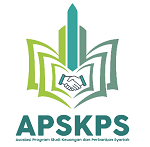Preparation of PSAK 109 ZIS Financial Statements Using Excel for Accounting for the Nurul Huda Jatiseeng Mosque
(1) Universitas Nahdlatul Ulama Cirebon
(2) Universitas Nahdlatul Ulama Cirebon
(*) Corresponding Author
Abstract
Â
Keywords:
PSAK 109, Microsoft Excel for AccountingFull Text:
PDFReferences
Aditya, A. (2019). Analisis Penyusunan Laporan Keuangamn Organisasi Nirlaba Menggunakan Microsoft excel. Sustainability (Switzerland), 11(1), 1–14. http://scioteca.caf.com/bitstream/handle/123456789/1091/RED2017-Eng-8ene.pdf?sequence=12&isAllowed=y%0Ahttp://dx.doi.org/10.1016/j.regsciurbeco.2008.06.005%0Ahttps://www.researchgate.net/publication/305320484_SISTEM_PEMBETUNGAN_TERPUSAT_STRATEGI_MELESTARI
Agustin, M. (2016). Penggunaan microsoft excel dalam penyusunan laporan keuangan untuk meningkatkan kualitas informasi laporan keuangan. 4(1).
Amelia, E., & Qibtiyah, M. (2015). Perlakuan Akuntansi Zakat Berdasarkan PSAK 45 dan PSAK 109 Pada BAMUIS BNI. The Journal of Tauhidinomics, 1(2), 183–198.
Ati Retna Sari, Delia Nurbatin, S. W. (2017). Aluntansi Keuangan Berbasis PSAK. Mitra Wacana Media.
Boedi Abdullah, B. A. S. (2014). Metode Penelitian Ekonomi Islam. CV Pustaka Setia.
Dewan Satndar Akuntansi Keuangan, D. (2014). PSAK Nomor 1 Tentang Penyajian Laporan Keuangan. Ikatan Akuntansi Indonesia.
Di, K., & Kabupaten, B. (2021). Organisasi Pengelola Zakat (OPZ) merupakan lembaga 20/03/2021 pengelola zakat yang diberikan kepercayaan untuk dapat. 1(2), 99–110.
Elvinda Febry Angraeni. (2016). PENERAPAN AKUNTANSI ZAKAT DAN INFAK/SEDEKAH BERDASARKAN PSAK 109. Jurnal Ekonomi Bisnis Dan Manajemen, 4. https://ejournal.unsrat.ac.id/index.php/emba/article/view/15257
Fati G N Larosa & Berupilihen br Ginting. (2009). Microsoft Excel For Accounting Cycle. CV Andi Offset.
Hadijah, S. (2019). Analisis Penerapan PSAK 109 Tentang Akuntansi Zakat, Infaq, dan Sedekah pada Badan Amil Zakat Nasional Kabupaten Majene. Journal of Economic, Public, and Accounting (JEPA), 1(2), 58–67. https://doi.org/10.31605/jepa.v1i2.297
Hamizar. (2012). Aplikasi Excel Untuk Akuntansi. Penerbit Lentera Ilmu.
Herry. (2014). Mahir Accounting Principles. Grasindo.
IAI. (2010). PSAK 109.
Ikatan Akuntansi Indonesia. (2008). ED.PSAK 109. DEwan Standar Akuntansi Keuangan.
Judhia, F. (2009). Pemanfaatan Microsoft Excel Dalam Pembuatan Laporan Keuangan. Media Informatika, 8(1), 28–42.
Kieso, D. E. (2010). Intermediate Accounting IFRS (1st ed.). JOhn Willey and sons.
M Irfan Firdausy. (2002). Zakat Profesi: Wacana Pemikiran dalam Fiqih Kontemporer. Cemerlang.
Muhajirin, A. L. (2020). Jurnal Ekonomika dan Bisnis Islam E-ISSN: 2686 – 620X Halaman 210 – 220. 3, 210–220.
Muhammad sanusi. (2009). Zakat Profesi: Wacana Pemikiran dalam Fiqih Kontemporer. salemba Diniyah.
QS AliImran 134. (n.d.). Al Qur’an.
QS AT Taubah 103. (n.d.). Al Qur’an.
Rahman, T. (2015). AKUNTANSI ZAKAT, INFAK DAN SEDEKAH (PSAK 109): Upaya Peningkatan Transparansi dan Akuntabilitas Organisasi Pengelola Zakat (OPZ). Muqtasid: Jurnal Ekonomi Dan Perbankan Syariah, 6(1), 141. https://doi.org/10.18326/muqtasid.v6i1.141-164
Rudianto. (2012). Pengantar Akuntansi Konsep dan Teknik Penyusunan laporan Keuangan. Penerbit Erlangga.
Rully Indrawan, P. Y. (2014). Metodologi Penelitian Kuantitatif, Kualitatif, Dan Campuran. Refika Aditama.
Sofyan Syafri Harahap. (2011). Teiri Akuntansi. Pt Raja Grafindo Persada.
Sugiyono. (2019). Metode Penelitian Kuantitatif Kualitatif dan R&D. Alfabeta.
UU No 23 RI. (2011). Undang Undang NO 23 Pengelolaan Zakat.
V. Wiratna Sujarweni. (2019). Metodologi Penelitian Bisnis Dan Ekonomi. PT Pustaka Baru.
Wasilah dan Sri Nurhayati. (2017). Akuntansi Syariah. Salemba Empat Pusta Pelajar.
Wulansari, S. dwi, & Setiawan, A. H. (2014). Analisis Peranan Dana Zakat Produktif Terhadap Perkembangan Usaha Mikro Mustahik ( Penerima Zakat ). Diponegoro Journal of Economics, 3(1), 1–15. https://ejournal-s1.undip.ac.id/index.php/jme
Yusuf, A. H. (2017). Dasar Dasar Akuntansi Jilid 1 (17th ed.). Bagian Penerbitan STIE YKPN.
Zakat, A., Psak, E. D., Cipta, H., & Indonesia, I. A. (2008). Pernyataan ini berlaku untuk amil yang menerima dan menyalurkan zakat dan infak/sedekah. 03. (Issue 109).
Thank you to the Ministry of Education, Culture, Research and Technology, Directorate General of Higher Education, Research and Technology
DOI: 10.24235/amwal.v13i2.8966
Article Metrics
Abstract view : 68 timesPDF - 11 times
Refbacks
- There are currently no refbacks.
Mailing Address
Department of Sharia Banking, Faculty of Islamic Economics and Business, UIN Siber Syekh Nurjati Cirebon
Jl. Perjuangan By Pass Sunyaragi Kesambi Kota Cirebon
E-Mail: journal.alamwal@gmail.com
![]()














